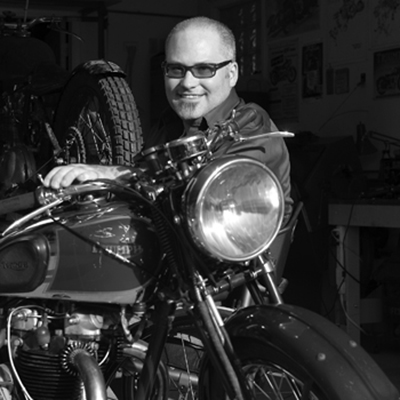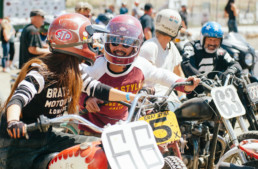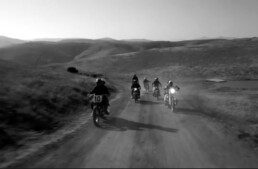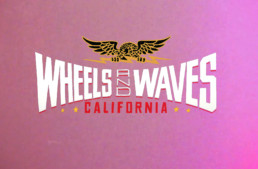


During his recuperation, his mom bought him the first U.S. release of Meet The Beatles in mono. He played it on repeat, and it was the soundtrack to his time in the dark. It was a pivotal moment, but music was just another aspect of creativity for Mike. His grandfather on his mom’s side was a musician who inspired him, and growing up, Mike sang in the church choir and toured the Western United States and parts of Canada. “And when I was in college, the guys who were guitar players all had great girlfriends, and we all thought that’s a pretty good way to meet girls,” he laughs. Between different bands and projects, including the country sounds of Mike Blanchard and the Californios (mikeblanchardandthecalifornios.com), he has produced five records. He says, “All good art is one good idea well realized – to me it’s all part of the same thing. I’m just a curious person and I love exploring making and creating; that act of creation is really intoxicating.”

Of his creative energy, he credits dad Jerry Blanchard for sowing the early seeds. “My dad is a craftsman and he taught high school machine shop. A lot of my parents’ friends were filmmakers or artists or musicians, and I was just super into making things. We spent a lot of time in the school shop after hours and on weekends as my dad was working on projects. The wood shop and the machine shop were connected, and we spent time in both. From an early age my dad taught us to weld, and I was making knives or swords. As well, my dad made a lot of crazy props for different movies. We were just taught to make things — my dad didn’t want to buy us toys or things like that, but he’d buy us a file or saw or give us a tool so we could just make our own.”

As a junior high school student, Mike and a friend made short movies – monster movies, American Civil War movies, Three Musketeers movies. “We’d sew the costumes and make the props,” Mike says. “My friend’s dad was into bikes, and he had an Indian Chief over the fireplace, a really nice 900SS Ducati and a gorgeous Ferrari in the garage.” While being surrounded by such desirable rides, the Blanchard’s daily driver was a 1934 Rolls-Royce 20-25 Gurney Nutting. “We were just super into vintage cars, too,” he says. “My dad had figured out Rolls-Royce makes the best car, and he found out he could buy a used Rolls-Royce for the same price he could buy a new Chevy – so he bought a used Rolls-Royce. I remember going to the port in Long Beach at night and watching the Rolls-Royce coming down the plank from the side of the ship – it was kind of crazy.”

Photography is a large part of Mike’s identity, and he’s held a camera in his hands since a teenager. “My dad’s best friend was a photographer and filmmaker, and he taught me how to shoot photos and how to develop stuff in the darkroom, but I really took after it when I got a Nikon for high school grad.” And there was no shortage of photographic inspiration. “Ansel Adams’ secretary was our next-door neighbor, my dad worked with Wynn Bullock’s wife, and some of his friends were Edward Weston’s sons – these were all people who were the cream of the crop of West Coast art photography. and I got to meet these guys and handle original artwork. That was all just curiosity, and being curious about life and creating things,” he says. Mike went to college to take Journalism and Photography, but he didn’t finish the program because in the 1980s he’d essentially talked his way into shooting for the seminal skateboarding magazine Thrasher as a staff photographer. “It was shortsighted, dropping out, because my parents were paying for it, but I thought why should I get a degree in journalism when I can just go do journalism?” He adds, “I did go back in my 50s, paid for it out of my pocket, and finished my Journalism degree at Sacramento State University.” Speaking about the transition from West Coast art photography to shooting half-pipe drop ins and backside axle stalls on pool edge coping, he says, “It’s trying to tell a story, and to make something visual and exciting. You look at art and you read books, that’s how you train your eye because you react to things instinctively in the moment.”

Mike had been skateboarding since 1973 or ’74, and he realized he likely wasn’t good enough to be a professional skater. With his camera skills, however, “I could have a career, if you will, in skateboard photography.” Speaking about his time with Thrasher, he says, “It was amazing. It was the heyday of skateboarding. There was a ton of money in it and people were flying all over the place. And the other interesting thing is, if you look at skateboarding and what’s come out of that, people who were really into skateboarding also moved on to art, motorcycles and hot rods. Guys like Steve Caballero, Max Schaaf, Rodney Jesse; all these guys were involved in other creative ventures, and I love that convergence. I’m convinced very few people are super laser focused on any one thing. Curious people, creative people, they have very broad interests and I like that intersection of various things.”

Hence, the very essence of RUST Magazine, a publication filled with well-written stories and Mike’s photography, and those of other shooters. As for Mike, he’s favored Nikon Fs as a film camera, together with a Rolleiflex. “They’re like different tools, appropriate for different things – sometimes I’ll use the Leica, sometimes the Rolleiflex or the Nikon, but the Fuji X100 is a digital camera I often have with me because it’s small and such a good camera. I also have a nice Nikon digital camera, but I’m just looking for an interesting look from a lens that might do something different.” He also appreciates vintage cameras. “The cameras from the 1950s and 1960s, there’s nothing better than that as a mechanical device,” he says. “They’ve moved on to plastics and computerized electronics and those cameras do a beautiful job but as a mechanical object they’re nowhere near in the class of quality as a ‘60s Rolleiflex or Leica, or an F or F2 Nikon – there’s nothing better than that.”

Another interest of Mike’s is wrenching. It’s an outgrowth of his dad’s influence. When getting some of his first vehicles on the road, which were motorcycles, he worked to keep a Kawasaki 500 triple in running condition. “You build up a kit of tools buying crappy vehicles to keep them going. At one point I had a mobile repair business, and then I was recommended to this great shop (Barber’s Shop Automotive in Sacramento) doing Alfa Romeo, Ferrari and Volvo – I ended up being one of the owners and started a motorcycle/scooter dealership (Scooter City) as part of the business and I ran that for 10 years. We did a ton of vintage motorcycle work and I built a bunch of bikes, but I sold my share in 2020.” One of Mike’s go-to rides is his 1974 BMW R90, but his collection includes an Aermacchi, a Vespa, several Hondas and a Gilera.


Mike’s a painter, too, and says working with oils and watercolors came along with his interest in photography because it helped train his eye. “You get to work with composition, color, and again, the best way to become a good photographer is to look at paintings and to read.” Recently, Hotwater Gallery in Carlsbad began showing some of Mike’s photography, and that’s something he’s excited about as he’s never been represented by a gallery. For the future, he plans to continue doing exactly what he’s been doing. “Playing with our three grandkids, writing some more stories, shooting some more photos, painting more pictures, playing more music. And I’m working on a book right now – I’ve just finished up my edit of hundreds of rolls of film and worked it down to 150 images; now I’ve got to make the final selections and write the copy for my book filled with skateboard photography. Speaking of always having something to do.” Follow Mike’s adventures on either of his two Instagram feeds; @rustmag and @thecalifornio.

He sums up his celebration of craft, craftspeople and those who are learning and the stories he runs in RUST Magazine with this, “When you make something, it’s an act of learning, it’s an act of love but you also learn. It doesn’t matter what it is; it is about constant problem solving. And you always have to be humble.”





Its interesting [ re; Vice’s – ” Let It Kill You ” ) how many boarders are turning to motorcycles , art and artistic endeavors later in life …. and yeah …. bikes .. cars etc …. I’ll give ‘ Rust ‘ a gander
Fair warning to all doing the same … there are two Rust magazines on line … one having absolutely nothing to do with this’n
Thanks for this Paul. I’ve been friends with Mike for quite a while now. He’s among the best of the best up here near Sac Town. The Californios are damn good as well.